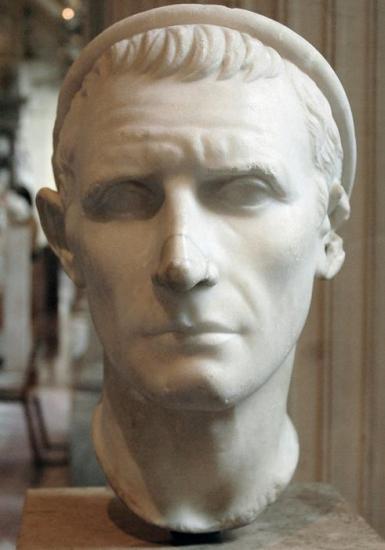Jessica Purkiss
Source - https://www.middleeastmonitor.com/articles/middle-east/16007-gaza-a-crossroads-of-civilisations

Antiochus III, The Great King (From a Bust in the Louvre)
In 201 BC King Antiochus captured Gaza. Polybius, a Greek Historian of the Hellenistic Period (period of ancient Greek and eastern Mediterranean history) recounted the incident in his work The Histories, which covered the period of 264-146 BC in detail.
He wrote: "It seems to me both just and proper here to testify to the character of the people of Gaza. Although in war they display no more valour than the people of Coele-Syria in general, they are far superior as regards acting in unison and keeping their faith; and to put it shortly show a courage which is irresistible."
He continues to give an outline of Gaza's history as evidence of the above: "For instance in the Persian invasion, when all other towns were terrified by the vast power of the invaders and surrendered themselves and their homes to the Medes, they alone faced the danger as one man and submitted to a siege. Again on the arrival of Alexander, when not only had other cities surrendered, but when Tyre had been stormed and her population enslaved; when there seemed to be scarcely any hope of safety for those who opposed the impetuous force of Alexander's attack, they were the only people in Syria who dared to withstand him and exhausted every resource in doing so....they left no possible means of resistance untried....."
Polybius' words were written centuries ago, but as Gaza rebuilds its shattered infrastructure after this summer's bombardment, they remain just as relevant. Through the centuries, Gaza has been captured by Assyrians, Egyptians, Babylonians, followed by Persians and later still by Alexander the Great, who placed it under siege. Since 1967, the occupier has been Israel, who in 2007 placed a land, air and naval blockade
In Jawdat Khoudary's museum in the north of Gaza, Roman anchors, Bronze Age vases and Byzantine columns tell the story of past empires and forgotten eras. The museum founded in 2008 by the entrepreneur and longtime collector of art and antiquities includes 350 artefacts from around 3,500 BC, most uncovered by Gazan fishermen and construction workers.
Gaza has a history that dates back to the Bronze Age. Through the centuries, it has been the crossroads of civilizations and a blooming economic hub of trade. However, for many people, knowledge of Gaza's history dates back to 1948, the year Israel was born.
"I have artefacts dating back to 3500 BC. If we had more excavations we would find more ancient items," said Khoudary. "We had our own coins in the fifth century B.C. made in Gaza with the Gazan logo," he said. "Not being knowledgeable of the history is ignorance and I try to challenge that ignorance."
Marc-André Haldimann, a researcher at the University of Bern in Switzerland and an expert on Mediterranean archaeology, curated an exhibition which was displayed in a Geneva museum in 2007 entitled: "Gaza at the Crossroads of Civilisations" "Gaza was built up by many civilisations," explained Haldimann. "Starting from Egypt, the Mesopotamia, then Greek and Roman civilisations, Persian and Arabic, all overlapping and mixing together."
According to Haldimann, Gaza has 17 major archaeological sites, which he describes as an "extensive network". The ruins of St Hilarion monastery (circa 4th C AD) were found when construction workers began digging to build a new road. Excavations carried out on Deir el-Balah beach revealed a cemetery dating back the late Bronze Age. Excavations at Tel Rafah, an ancient settlement in southern Gaza, revealed treasures including coins, pots and glass dating back to the Canaanite era.
"Underneath Gaza there is a whole other Gaza," said Hayam Albetar, an archaeologist at the Ministry of Tourism and Antiquities, to the BBC. "We found a Byzantine Church when workers were digging to build Salahedin Street and stumbled upon a mosaic."
Gaza's ancient treasures have lured in archaeologists from around the world, including British archaeologist Sir Flinders Petrie, who excavated a site called Tell el-'Ajjul in the 1930s. Like many of the objects found in such digs, the material excavated by Petrie in Gaza ended up in museums all over the world.
Some of the uncovered artefacts ended up in the University of London's Institute of Archaeology, where curator Rachael Sparks says items such as cosmetic containers, bone dice and a pottery jug with painted Proto-Canaanite inscription are on display. Many more items, she says, were sent to Jerusalem, and are now in the Rockefeller Museum, while other pieces ended up in various museums in the rest of the UK, USA, Australia, and Japan.
Other remnants of Gaza's ancient history are now displayed in what Haldimann calls "lavish exhibitions" in Israeli museums. The dig at Deir el-Balah, for example took place under army guard and uncovered gold jewelry, alabaster vessels and, most important, coffins. Most of this went to Israel Museum, but some were added to the personal collection of Moshe Dayan, Israel's defense minister at the time.
For Gazan's, most of whom struggle to leave the blockaded strip, it is unlikely they will see the remains of their ancient history in display in museums across the US and Europe. Khoudary's collection offers a glimpse into a time where Gaza was at the crossroads of civilisations, an essential route on the trade map and at the heart of an important journey for pilgrims across the world.
"Gaza has suffered more than most cities," Khoudary said in an earlier interview to New York Times. "There was the siege of Alexander the Great and of the Persians and of the British." He added: "At the end of the day this siege will be a footnote."